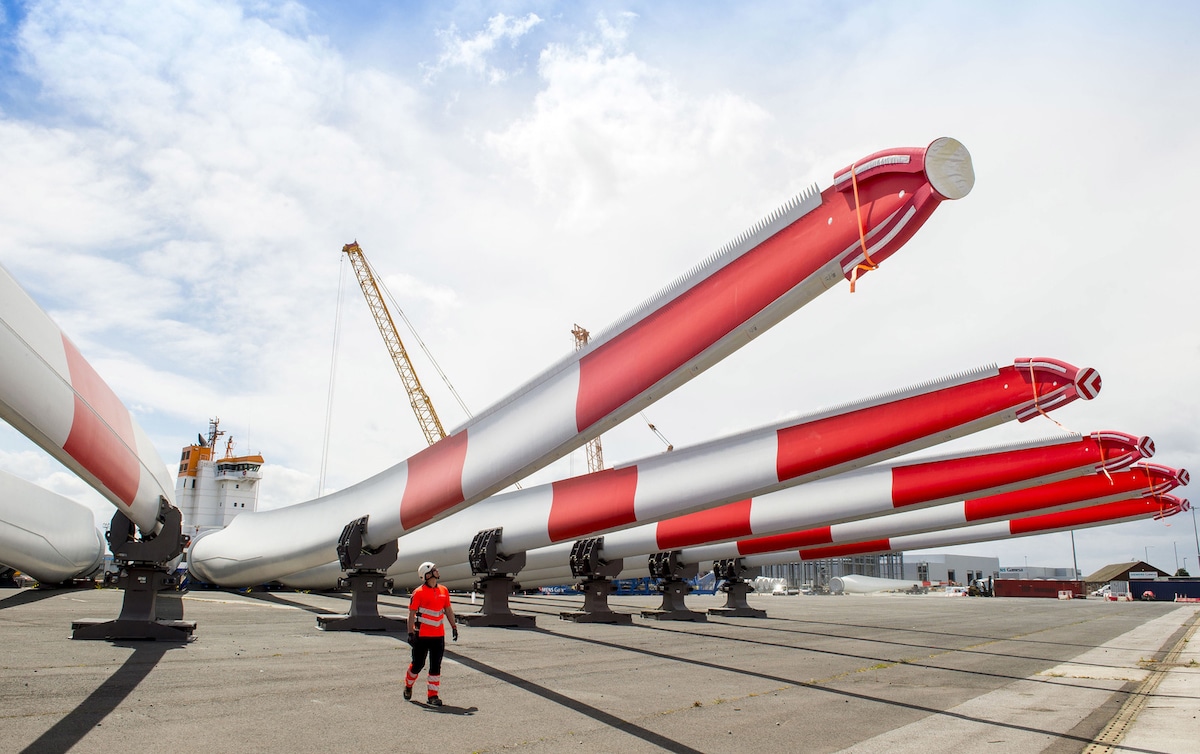Products You May Like
Recyclable wind turbine blades being transported from a Siemens Gamesa factory in Hull, UK. Siemens Gamesa
 Why you can trust us
Why you can trust us
Founded in 2005 as an Ohio-based environmental newspaper, EcoWatch is a digital platform dedicated to publishing quality, science-based content on environmental issues, causes, and solutions.
One of the greatest environmental challenges of the renewable energy transition is ensuring that the new energy-generating devices themselves — from solar panels to wind turbines to lithium batteries — are made and disposed of sustainably.
That’s why it’s promising that recycled turbine blades are catching wind. Major turbine maker Siemens Gamesa announced Thursday that some of its recycled blades would find a home in the UK’s Dogger Bank wind complex, one of the largest offshore wind farms in the world.
“Our industry-leading RecyclableBlade technology is now delivering even greater circularity of resources,” CEO of Siemens Gamesa’s offshore business Marc Becker said in a press release.
Wind turbine blades are typically built around a core material like wood or polyethylene terephthalate foam (PET) with glass, carbon fiber and a resin, SiemensGamesa explained. While 85 percent of the average turbine is recyclable in theory, it has been difficult to recycle the blades because of the challenge of separating the materials from the resin after the blade has been cured. Because of this, most turbine blades are landfilled, and they make up around 10 percent of Europe’s fiber-reinforced composite (FRP) waste. This waste poses a problem in landfills because it takes up space, contaminates soil, air and groundwater and can even spread infectious diseases, according to the Scholarly Community Encyclopedia. Because of this, several European countries have banned FRP waste in landfills altogether, Siemens Gamesa said.
More From EcoWatch
To solve the problem of wind turbine disposal, Siemens Gamesa developed its RecyclableBlade by using a different type of resin that is easier to separate from the other components at the end of a turbine’s life. The recycling process comes in four stages:
- Removing the blades from the turbine.
- Heating the blades in a mild acidic solution until the components separate.
- Removing the separated components and readying them for reuse.
- Giving the old ingredients new life, for example in the automotive industry or in casings for flat-screen TVs.
Siemens Gamesa’s RecyclableBlades were used for the first time at a commercial scale in 2022, according to the press release. German energy company RWE first installed them in its Kaskasi offshore wind power project in the German North Sea.
Now, RWE is working with Siemens Gamesa again, placing the largest commercial order for recyclable turbine blades. Forty-four of 100 turbines in RWE’s Sofia offshore wind project will have the recyclable blades, RWE said in a press release. Sofia is one of four wind farms planned for the UK’s Dogger Bank in the North Sea, as Elektrek explained. It is also RWE’s largest offshore wind project.
“We are delighted to have secured this agreement with Siemens Gamesa. Sofia is our largest offshore wind farm to date and this world first is a significant step in taking the long-term sustainability of offshore wind farms to the next level,” RWE Offshore Wind CEO Sven Utermöhlen said in the RWE release. “RWE believe this is the right direction for the future of our sector, which has sustainability at its core.”
The 132 blades in the order will be the first 108-meter long B108 RecyclableBlades used in the field, Siemens Gamesa said.
“When we began working with RWE on the Kaskasi project, we knew that we had taken the first major steps toward delivering a decisive change to the wind sector. Having the opportunity to produce and install 132 RecyclableBlades for the Sofia project is a remarkable achievement. It fully demonstrates the joint focus between our companies to develop and deliver even greater levels of sustainability for renewable power generation globally,” Becker said.
All of the Siemens Gamesa blades will be made in a factory in Hull, UK, while 50 percent of the Sofia blades overall will be made in the UK, RWE pledged. Siemens Gamesa is working towards a goal of making 100 percent recyclable turbines by 2040.
Subscribe to get exclusive updates in our daily newsletter!
By signing up, you agree to the Terms of Use and Privacy Policy & to receive electronic communications from EcoWatch Media Group, which may include marketing promotions, advertisements and sponsored content.
